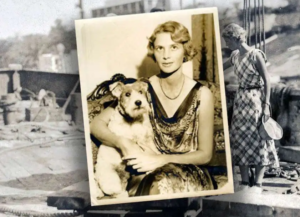Gloria Hollister and her Disappearing Fish
Do you admire women who seize the chance to do what few other people have done? To count down the days to National Kick Butt Day, October 14, I am celebrating ten adventurous members of the Society of Woman Geographers (SWG). The ninth person to be honored is Marine Biologist Gloria Hollister.
Gloria and her Dog and the Bathysphere
In 1930, biologist Gloria Hollister was working in Bermuda with naturalist William Beebe. Originally trained as an ornithologist, Beebe was now studying marine life with the aid of a bathysphere, a metal diving globe lowered into the water by a cable. He had gone on several test dives, and Gloria was almost mad with the desire to go down in the submersible. She started hounding Beebe as soon as he took the first dive on May 27. On the morning of June 11, Beebe descended for the third time: to a depth of 1426 feet.
After the dive, Will announced that Gloria and his assistant, John Tee Van. would make a descent that afternoon. Gloria was delighted! She would be a passenger on the fourth manned descent of the bathysphere. Gloria recalled: “I had forgotten it was my 30th birthday. It was the strangest and most desirable birthday present in the world.”
At 12:32 p.m., Gloria and John squirmed through the 14-inch hatch and into the steel ball, which was four feet, nine inches across. Inside, there was no suggestion of comfort—only the hard, concave, black-painted steel, two oxygen tanks, and a telephone set. The door slammed into place with a loud clang, and Gloria heard the crew hammer the ten large bolts into place with a sledgehammer. The sound was deafening inside the diving bell.
As she looked out of the three portholes, she could see the boat’s large winch, which would lower the bathysphere into the water. Through her headphones, she heard Will say, “You’re off.”
She felt a jolt, and suddenly she was swaying. “But for the telephone communication, I might have been an isolated planet swinging in mid-ether!”
The 5,000-pound bathysphere halted for a moment and then plunged into the ocean. All that separated Gloria from the water’s crushing pressure was a steel wall. 1.5 inches thick. As the winch lowered the steel ball, Gloria saw air bubbles rising in the water, bathed in the sunlight. As she descended deeper, the sunlight disappeared, and the water became blue-green. Jellyfish and shrimp floated by, and “fish butted savagely against the window and darted away into blue space.” It never occurred to her to be frightened: “I was far too interested in what I was seeing. Only once, when I felt a drop of water, did I even think of anything going wrong. When I realized it was moisture from condensed air, I again completely forgot about the bathysphere.”
At 410 feet below the surface, she asked Beebe to lower them another one hundred feet. She wanted to get past the twilight zone so that she could see the bioluminsescent sea creatures. He refused, and she felt the winch start to pull up the bathysphere.
Lecture Advertisement, Library of Congress
When the crew hammered out the bolts and opened the 14-inch hatch, Gloria “emerged from her steel chrysalis, excited by the unforgettable experience of this hour.” It was not her only dive, but it was her most memorable. She had set the record for the deepest dive of any woman. She had descended deeper than a submarine.
When she attended the annual meeting of the Society of Woman Geographers in New York that winter, she described her bathysphere ride to an enthralled audience. “This has opened up a whole new world for scientific investigation. I am proud to be the only girl who has adventured into the ocean.” Despite her remarkable presentation, a Minneapolis Star journalist who covered the formal event reported that Gloria looked “more like one of Ziegfeld’s glories than a scientist.”
But this was nothing new. Advertisements for Gloria’s lecture series noted: “She looks like a musical comedy star, but she has one of the finest scientific minds ever found in a woman.” The Family Circle published an article about Hollister under the banner: Gloria, the beautiful ichthyologist or “Some Blondes Have Brains.” Others pictured her in a bathing suit with the 60-pound copper diving helmet she used to explore the deep when she was not in the bathysphere.
When Gloria wasn’t diving, she worked on the difficult problem of observing a fish’s skeleton without dissecting it. She and Anna Wright worked in Beebe’s laboratory, which she affectionately called “The Clearing House,” for it was where they made fish clear, and where they had many noisy discussions. The Bermudans called it the House of Magic because Gloria mysteriously turned fish transparent there. Gloria thought: “History recalls that not many years ago a woman was burned to death on St. David’s Island nearby, as a witch, for working minor magic; I could easily qualify if those days were not past.”
Gloria and her Dog
Gloria found that “beauty is not skin deep” when she applied a combination of dyes, bleaches, and chemicals to the fish: “Every bone, tendon, muscle and fiber assumes an individuality, with a characteristic pattern.” When she poured the dye concoction over the fish, its body faded away, and its bones became permanently visible for study.
The process was complicated. Gloria immersed the fish for hours in alizarin, a staining agent, which colored the bones scarlet. When the skeleton was stained, Gloria gave the fish a series of bleaching and ammonia baths to decolor the fish’s skin and tissues. Then, she soaked the fish in potassium or sodium baths to rid the bones of scarlet and produce a “transparent, ghost-like form.”
Gloria found the technique to be much more reliable than the x-ray, for it allowed her to study the specimen rather than a photographic plate. Also, the dye produced a much cleaner and clearer image. It was also much easier than dissecting the fish.
Gloria’s “Fish Magic,” Wildlife Conservation Society
By experimentation, she learned that, contrary to expectations, fresh fish produced a better result than preserved fish: “It was almost unbelievable to see the scarlet skeleton of a small trigger-fish, apparently suspended in mid-fluid, with the remainder of the fish wholly invisible—and to remember that only twelve hours before, the little fellow had been swimming, happy and opaque.” She believed that she had set “a time record for producing a perfectly stained and cleared transparency.” She recalled: “The skeletons tell us invaluable things about the habits of all these deep-sea fish, which we may never be able to study in the icy submarine haunts.”





-Comments-